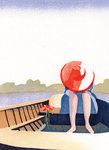

When artist Matthew Bohan isn’t creating illustrations for medical professionals, he paints water birds — blue herons specifically. He acquired an affinity for the winged water creatures as a regular on the River Trail. Years ago, the painter captured a fleeting moment of a heron taking off with a fish in its beak – a reminder of nature’s ephemeral state.
Bohan’s still life of the fleeing heron is one of three murals going up on the retaining wall of a parking lot north of Joann Fabrics in Frandor Shopping Center. Wednesday marks the official ribbon cutting, inviting residents to learn more about the new project series and its connection to a larger, environmental initiative.
“People who have not been down to the River Trail may not know what is along the river,” Bohan said referring to his mural. “If you go there then you’ll think ‘OK, how do we protect this?”
The group behind the Frandor murals is Art in the Wild, a nonprofit with a mission to educate the community on how to protect the Red Cedar River. The murals started as photographs of artwork that were enlarged and printed on adhesive PVC material that will be heat-transferred onto the three cement walls of the parking lot. The technique of printed —opposed to hand painted — murals is growing in popularity for public art projects for its guaranteed three to four-year life span.
The murals are just one of several artistic sites Art in the Wild hopes to bring to the Frandor area. The nonprofit started around four years ago when Melody Angel, the board president of Art in the Wild, and her husband, Pat Lindemann, the Ingham County drain commissioner, realized that their local presentations on water pollution only attracted those already familiar with low impact living. The environmentalists started dreaming up ways to get the attention of all Lansing residents and settled on creating a $10 million art destination.
“I’m going all the way or nothing,” Angel said about her ambitious project. “Each artwork is going to have a short, environmental message that anyone can relate to that teaches them about how to keep the Red Cedar River clean.”
Elevated to the sacred
Using the allure of beautiful artwork, Angel hopes to create a welcoming environment for passersby to learn daily habits to reduce water pollution. To assist her with the visuals, she sought the help of artists like Bohan and Linda J. Beeman, a visual arts instructor at Interlochen who has been an environmental advocate for 12 years.
Beeman, 61, is the product of a long line of Michigan farmers who emigrated from New York in the 19th century. Her grandmother grew up on a farm in Bennington Township and taught Beeman to appreciate nature.
Through moku hanga woodblocking — a waste-free Japanese printmaking method — Beeman made a 12-by-18-inch replica of a photograph of her grandmother that will be enlarged to scale one of the three connected parking lot walls.
“It was a little 2-by-2-inch sepia-toned photograph that my grandfather took when they were courting and she was sitting in a boat and has this big hat, so he can’t see her face, because she is very shy,” Beeman explained.
Beeman discovered moku hanga online while she was searching for nontoxic art materials that would not irritate her skin. The water-based process involves applying watercolors to carved wooden blocks that are then pressed on to a flat surface. The process leaves behind faintly pigmented prints that reveal the subtleties of color and tone — which is ideal when painting landscapes, according to Beeman.
It is tradition in moku hanga to depict nature. On Beeman’s website, she explains how the medium brings attention “to the vulnerability of our natural spaces” causing “the rarely noticed or hidden” to become “elevated to the sacred.” While Beeman’s submission isn’t a literal image of nature, it emphasizes an important link to it through ancestry and the quiet, often unseen, beauty of its inhabitants.
High stakes
Angel said that the stakes of losing access to clean water in Lansing are what makes her dream worth chasing.
She referenced the steel sculpture entitled “Portrait of a Dreamer” located in downtown Lansing, which she said cost around $75,000, as the level of grandeur imagined for the future installations. The board president remarked the end goal for the project is to have “about 100 major sculptures” stretching from Ranney Park to the Red Cedar Park.
The location for the art installation was determined by an ongoing project to clean the storm water of the Montgomery Drain — the watershed that extends one mile north of Frandor and empties into the Red Cedar River.
Efforts to rebuild the failing infrastructure of drain pipes, as well as install wetlands and waterfalls for natural filtration, have taken 20 years, Angel said. This is largely due to the hefty public funding required to sponsor the project. In the meantime, Angel thought of a creative way to inform residents — without using taxpayers’ money — of the small things they can do to reduce water pollution.
Last year, Art in the Wild secured its nonprofit status. Angel is building a team to assist with grant writing to gather funding from backers in Michigan and beyond. She’s also in the brainstorming stage of integrating a diverse range of voices in future installations. The board president has started this process by speaking with a former Lansing area principal on ways to have students from school districts across the tri-county area produce art for the destination.
“To have a goal that is bigger than life and then to just really go for it and enroll everyone else in that possibility, it makes all of us believe that big things can happen in our lives,” Angel said.
“Murals on Frandor” Unveiling
Wednesday, July 10, Noon
Joann Fabrics
533 Mall Ct., Frandor, Lansing
Support City Pulse - Donate Today!
Comments
No comments on this item Please log in to comment by clicking here